Paracord
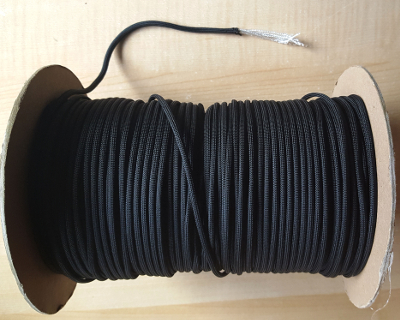
Paracord by Jedidiah Forsyth
Most folks who have even a casual interest in wilderness survival, or outdoor recreation in general, have probably heard of paracord. Paracord, or parachute cord, is one of the most useful pieces of kit we can take with us into the outdoors, so let’s take a look at it and why it’s so great.
Construction and Properties
Parachute cord is constructed of a braided outer nylon sheath and a number of internal strands. There are actually at least five different types of paracord. Generally speaking when people talk about paracord they are referring to Type III paracord. The different types of cord are defined by their diameter, tensile strength, and number of internal strands. Paracord is often referred to 550 cord in reference to the tensile strength, or minimum breaking strength, of Type III paracord which is 550 lbs.
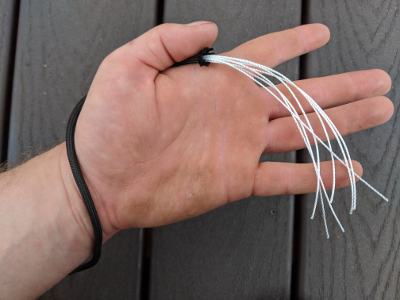 Type III Paracord, or 550 cord, with outer braid pulled back to reveal inner strands. These strands can be pulled out when you are in need of a finer cordage.
Type III Paracord, or 550 cord, with outer braid pulled back to reveal inner strands. These strands can be pulled out when you are in need of a finer cordage.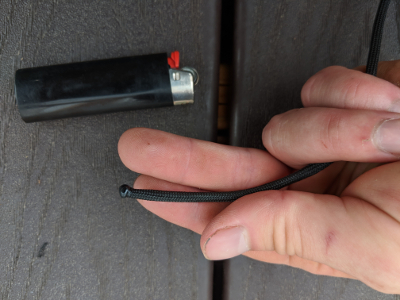 If left loose, the inner strands can start to come out uncontrollably. Melting the end like this is an effective way to keep the ends tidy.
If left loose, the inner strands can start to come out uncontrollably. Melting the end like this is an effective way to keep the ends tidy.Uses of Paracord
There are an almost endless number of applications for cordage in the outdoors, almost regardless of activity. Oftentimes we don’t realize how much we rely on cord until we don’t have any. Used as is, paracord is lightweight and strong, but we can strip off the outer sheath and separate the inner strands for a smaller thread.
Some applications for paracord include:
• Hanging a bear bag
• Shelter building
• Flying a tarp
• Sewing thread / equipment repairs
• Cord for friction fire
• Survival traps / snares
• Bow strings
• Lanyards
• Fishing line
• Lashings
Be More Prepared For Your Next Outdoor Adventure!

Don't leave without knowing these six essential survival skills. Our free survival mini guide reveals the strategies of:
- Shelter & fire to prevent the number one cause of death
- Obtaining clean water to avoid life-threatening dehydration
- Common wild survival foods and other critical skills!

With the increasing popularity of bushcraft and survival skills folks have come up with a number of novel ways of carrying paracord. Because of the diverse survival applications of paracord it may be a good idea to experiment with some of these techniques so you don’t need to be caught out without cord when you need it.
Some ideas include:
• Replacing shoe laces
• Paracord lanyards / straps
• Braided paracord bracelets, belts, etc.
• Whipping on tool handles
Even if you don’t use some of these more creative techniques, it is a good idea to throw a bundle of paracord in your pack. Bushcraft legend Mors Kochanski often states that any spare room in your survival kit should be packed with paracord. I usually carry about 100 ft. of paracord if I can.
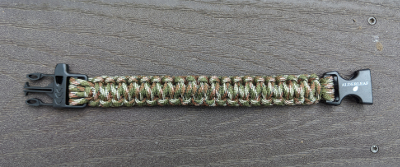 Paracord bracelets like this can be a convenient way to carry a few extra feet of cordage.
Paracord bracelets like this can be a convenient way to carry a few extra feet of cordage.Additional Considerations
Paracord can be purchased online in 1000 ft. spools or sourced from local hardware or sporting goods stores. There are typically a diversity of colors available. Black and camo tend to be very popular, but I prefer to use a brighter color such as blaze orange, which is easier to keep track of.
When paracord is cut to reveal the inner strands, the outer sheath will tend to slip. To prevent this from happening the ends of the cord can either be melted or tied off.
Paracord is relatively slick, so some knots won’t work particularly well. Experimentation will is the key to success.
If possible you should try to conserve your cord by not cutting it unnecessarily.
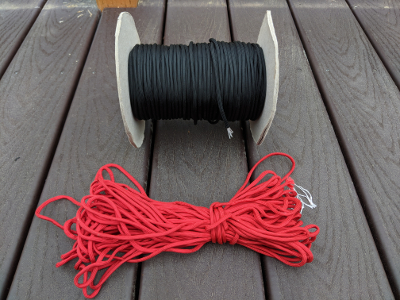 Several hundred feet of paracord in a commercial spool. The red paracord is something I like to carry with me because it is more visible.
Several hundred feet of paracord in a commercial spool. The red paracord is something I like to carry with me because it is more visible.In summation, paracord is what of the most valuable and versatile pieces of equipment you can bring into the woods, and really has no natural substitute. You could spend hundreds of hours attempting to make a cordage of this caliber with natural materials, and very likely still fall short of the mark. If you have never used paracord I highly recommend picking some up next time you head into the field; I have no doubt you will be happy with its utility.
By the way, if you enjoyed this article then you'll love our survival mini guide. You'll discover six key strategies to staying alive in the outdoors plus often-overlooked survival tips. We're currently giving away free copies here.
Related Resources:
How to Make a Paracord Bracelet - REI
Wilderness Survival Courses at Alderleaf

About the Author: Jedidiah Forsyth is an experienced outdoor educator and wildlife tracker. He is a guest instructor at Alderleaf Wilderness College. Learn more about Jedidiah Forsyth.
Return from Paracord back to Wilderness Survival Articles
Is The Essential Wilderness Survival Skills Course Right for You? Take the "Online Survival Training Readiness" Quiz
See for yourself if this eye-opening course is a good fit for you. It takes just a few minutes! Get your Survival Training Readiness Score Now!

Grow Your Outdoor Skills! Get monthly updates on new wilderness skills, upcoming courses, and special opportunities. Join the free Alderleaf eNews and as a welcome gift you'll get a copy of our Mini Survival Guide.

 The Six Keys to Survival: Get a free copy of our survival mini-guide and monthly tips!
The Six Keys to Survival: Get a free copy of our survival mini-guide and monthly tips!
Learn more